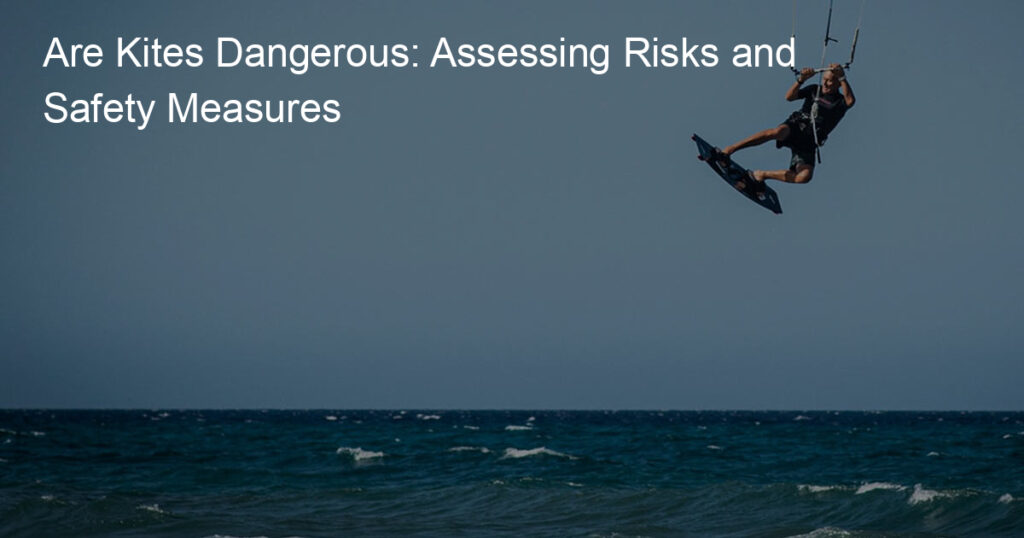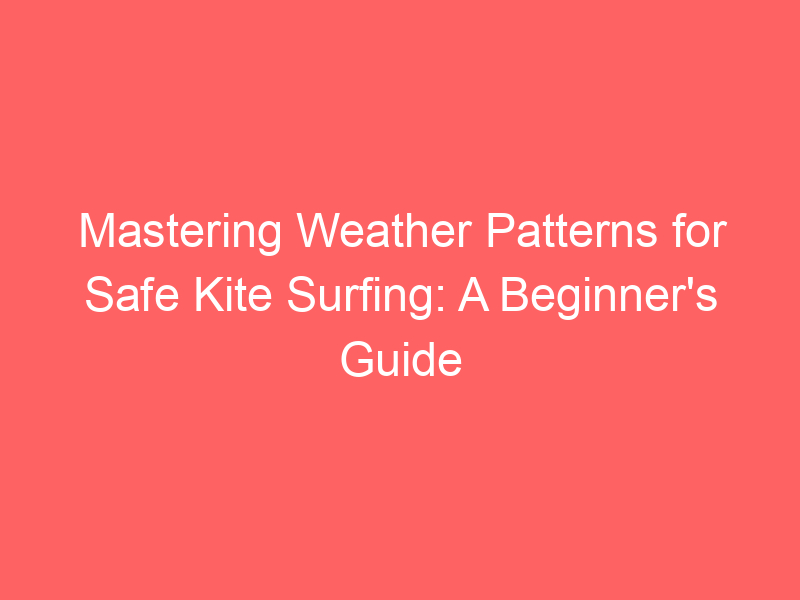Kitesurfing, a popular water sport that combines elements of surfing, windsurfing, and paragliding, can be an exhilarating experience. However, like any adventure sport, it comes with its own set of risks and dangers.
Many people wonder if are kites dangerous activity, and the answer can vary depending on the individual’s skill level, the conditions they are kiting in, and the precautions they take.
To better understand the potential dangers associated with kitesurfing, it is crucial to analyze the various hazards that kitesurfers may encounter.
These can include equipment failures, weather, and nautical hazards, obstacles in the water, and interactions with other people on the water.
By learning about these risks and taking necessary safety measures, kitesurfers can minimize the chances of accidents and enhance their overall experience on the water.
Key Takeaways
- Kitesurfing carries inherent risks, but understanding and addressing them can minimize danger.
- Weather, equipment, and personal skills play key roles in kitesurfing safety.
- Taking appropriate safety measures and learning from experienced surfers can greatly enhance enjoyment and minimize risk.
Are Kites Dangerous?

Kite surfing is a popular water sport that involves riding on a surfboard while being pulled along by a large kite. You might wonder if this adrenaline-pumping activity is dangerous or safe.
Like any other water sport, kite surfing has its risks, but by being well-prepared and following safety guidelines, you can minimize these risks and enjoy a thrilling experience.
Firstly, it’s essential to be aware of the weather conditions and nautical hazards before you start kite surfing. Rapid weather changes can be dangerous, especially if you’re not familiar with the location.
Your safety depends on your knowledge and understanding of the predicted weather and wind for the day.
Next, you should consider your equipment. Equipment failures can be a significant risk. Always maintain your gear in good condition, and double-check everything before you hit the water.
Choose the right kite size and board according to your skill level and the current conditions.
Another crucial aspect is having proper training. A certified kitesurfing instructor can teach you essential techniques, from launching the kite to managing safety systems effectively.
Proper training and following safety guidelines greatly minimize the risks associated with kitesurfing.
It’s also important to note that there are potential underwater hazards, such as rocks, reefs, and marine life. Familiarize yourself with the local waters, and remember to wear the necessary protective gear, like wetsuits, helmets, and booties.
Finally, always be respectful and considerate of others in the water. Avoid crowded areas and give other water users plenty of space.
Following these guidelines, you can reduce the risks associated with kite surfing and have a safe and enjoyable experience.
Reasons Why Kite Surfing Can Be Dangerous

High Wind Speeds
Kite surfing relies on wind to propel you across the water. However, when wind speeds become too strong, it can lead to dangerous situations. High wind speeds can cause you to lose control, making it difficult to steer or even stop your kite.
In some cases, it may even result in you being dragged out of control across the water or into obstacles, which can lead to injuries or accidents.
To minimize the risks, always monitor the weather conditions and follow the advice of experienced kitesurfers when selecting the right kite for the conditions.
Inadequate Training
Kitesurfing is a physically demanding sport, and without proper training, the risks can be much higher. Inadequate knowledge of safety procedures, inadequate kite-handling techniques, and poor decision-making can lead to dangerous situations.
To minimize these risks, invest time in proper training and lessons from certified instructors before attempting to kitesurf on your own. This will help ensure you have the skills necessary to navigate the water safely and enjoy the sport responsibly.
Equipment Quality
The quality of your kitesurfing equipment plays a significant role in your safety. Using damaged or low-quality gear can increase the risk of accidents and injuries, so it’s important to maintain your equipment and replace it when needed.
Always inspect your gear before each session, looking for signs of wear or damage. Additionally, purchasing equipment from reputable brands and retailers will help ensure you have a reliable and safe setup.
By understanding and addressing these factors, you can greatly reduce the risks associated with kitesurfing and have a safer, more enjoyable time out on the water.
How Accidents Occur in Kite Surfing

Kite surfing can be a thrilling and enjoyable water sport, but like any other activity, it also comes with its share of risks. In this section, we’ll discuss two common scenarios that may lead to accidents in kite surfing: Kite Control Loss and Collision With Obstacles.
Kite Control Loss
One of the primary challenges faced by kitesurfers is maintaining control of their kite. Losing control of the kite can occur for a variety of reasons, such as:
- Getting overpowered: Your kite might be too large for the current wind conditions, making it difficult to manage and ultimately causing you to lose control. This is more probable for newer kiters.
- Poor kite handling skills: Inadequate training or lack of experience can lead to improper handling of the kite, potentially resulting in an inability to maintain control.
To minimize the risk of losing control of your kite, make sure to choose the appropriate kite size for the wind conditions, invest in proper training, and gradually increase your skill level with consistent practice.
Collision With Obstacles
Colliding with obstacles is another potential hazard in kite surfing. This can happen in different ways, such as:
- Kite lines entanglement: Becoming entangled with your own or other kiters’ lines is one of the most dangerous aspects of this sport. Always be aware of your surroundings and practice effective communication with fellow kiters to avoid any collisions.
- Crashing into objects or other kiters: It’s crucial to maintain a safe distance between you, other kiters, and any obstacles present in the water. Pay attention to your surroundings and follow any posted guidelines or rules for the area you’re kite surfing in.
By understanding the risks and taking the necessary precautions, you can significantly reduce the chances of being involved in an accident while kite surfing.
Remember to always wear appropriate safety gear, such as a life jacket and helmet3, and follow all recommended safety procedures to ensure an enjoyable and safe kite surfing experience.
Safety Measures to Reduce Risk

Kite surfing can be an adrenaline-pumping sport, but it also comes with certain risks. By taking proper precautions, you can enjoy this exciting activity while minimizing potential dangers.
In this section, we will discuss three key safety measures to reduce risk in kite surfing: proper training, safe equipment, and appropriate weather conditions.
Proper Training
First and foremost, obtaining proper training is crucial for staying safe on the water. Experienced instructors can teach you essential techniques, such as how to control your kite, maintain balance on the board, and handle challenging situations.
Make sure to invest time in mastering these skills before venturing out on your own or in stronger winds. Remember, a strong foundation in kite surfing will help you prevent accidents and stay in control.
Safe Equipment
Next, it’s essential to use safe equipment while kite surfing. Investing in high-quality gear will reduce the chances of accidents caused by breakage or malfunction.
This includes:
- A sturdy kiteboard
- A properly fitted harness
- A dependable kite and bar system
- A reliable safety leash
Additionally, it’s vital to inspect your gear regularly to ensure it’s still in good working order. Repair or replace any worn or damaged components promptly to maintain your safety.
Appropriate Weather Conditions
Lastly, kite surfing in appropriate weather conditions will help minimize risks. Be mindful of the following factors:
- Wind speed: Choose a kite size that matches the current wind conditions. Utilize wind forecasts and real-time data apps to ensure you’re aware of any sudden changes.
- Wind direction: Aim to kite surf in side-shore or side-onshore winds, as offshore winds can carry you out to sea.
- Tides: Check the tide timetable and be aware of reefs, sandbanks, and other obstacles that may become hazards during low or high tide.
- Other weather conditions: Stay alert to changing weather patterns, including storms and water temperature changes.
In summary, by prioritizing proper training, using safe equipment, and monitoring weather conditions, you can significantly reduce the risks associated with kite surfing and maximize your enjoyment of the sport.
The Role of Adventure Sports Companies

Adventure sports companies play a crucial role in ensuring the safety of kite surfers. By providing necessary precautions and following proper guidelines, they can minimize the risks associated with this thrilling water sport.
Let’s delve into the specific measures these companies take to keep kite surfing as safe as possible.
Provision of Qualified Instructors
An essential aspect of maintaining safety in kite surfing is having qualified instructors on hand to guide participants. These instructors are well-trained and experienced in the sport, ensuring that you receive proper coaching.
They are responsible for teaching you essential techniques, such as controlling the kite, maintaining balance on the board, and handling various weather conditions.
Further, qualified instructors emphasize the importance of safety measures, including proper use of equipment, understanding weather patterns, and staying aware of your surroundings.
By following their guidance, you can significantly reduce the risks involved in kitesurfing.
Maintenance of Equipment
Another way adventure sports companies contribute to kite surfing safety is through regular maintenance of equipment. High-quality gear and properly maintained equipment play a vital role in minimizing hazards during kite surfing sessions.
Companies should ensure that all equipment, such as kites, boards, harnesses, and safety gear, are in good working condition. They must keep a close eye on signs of wear and tear and replace faulty equipment promptly.
As a participant, relying on well-maintained gear from these companies can help you avoid issues related to equipment failures and make your kite surfing experience more enjoyable.
Remember, your safety while kite surfing depends on both the knowledge and guidance provided by qualified instructors and the reliable equipment offered by adventure sports companies.
By choosing a company that prioritizes these factors, you can enhance your kite surfing experience and reduce the risks associated with this exciting water sport.
Frequently Asked Questions
Is kitesurfing riskier than windsurfing?
Kitesurfing may be considered riskier than windsurfing due to the powerful lift that the kites can generate. However, with proper training and safety precautions, both sports can be relatively safe.
It’s essential to learn these sports from certified instructors and always be aware of your surroundings to minimize the risks.
What safety precautions should be taken while kitesurfing?
To ensure a safe kitesurfing experience, follow these precautions:
- Take lessons from a certified instructor.
- Always wear a helmet, impact vest, and harness.
- Use a kite leash to prevent losing control of your kite.
- Be mindful of the weather and wind conditions.
- Never kite alone. If you must, take a means of calling or signaling for help.
- Avoid kitesurfing in crowded areas or near obstacles.
Can you get injured while kitesurfing?
Yes, injuries can occur while kitesurfing, especially if you are not following safety precautions or are inexperienced. However, with proper training, equipment, and awareness, the risk of injury can be minimized.
What are common kitesurfing injuries?
Common kitesurfing injuries include:
- Cuts and abrasions are usually caused by contact with the kite lines, board, or other obstacles.
- Sprains and strains, often due to sudden movements or falls.
- Bruises and contusions, typically from impacts with the water or equipment.
- More severe injuries, such as fractures or dislocations, can occur during high-impact crashes or collisions.
How do kite surfers maintain control?
Kitesurfers maintain control by steering their kite with a control bar and adjusting their body position on the board. They also use their harness to transfer the kite’s power to their body, allowing them to maneuver effectively.
To ensure better control, kite surfers should constantly observe their surroundings, consider weather conditions, and react accordingly.
Is kitesurfing hard on the body?
Kitesurfing can be physically demanding and may put some stress on your body, particularly on your arms, legs, and core muscles.
However, if you maintain proper technique, use the right equipment, and take care of your body with regular stretches and exercises, kitesurfing should not be excessively hard on your body.








